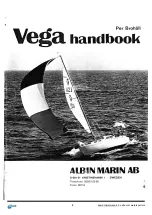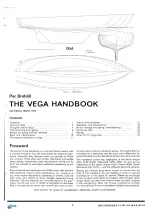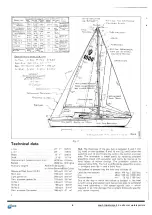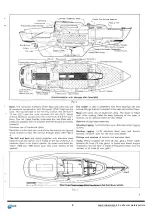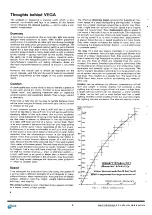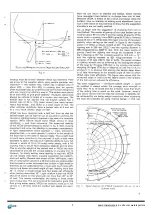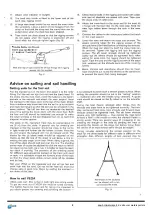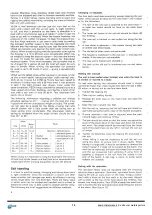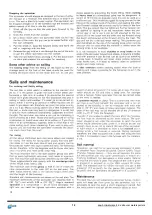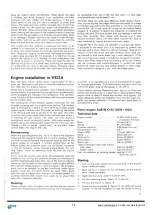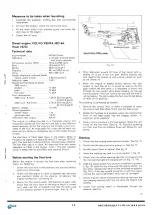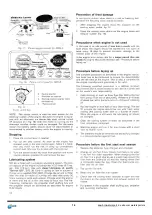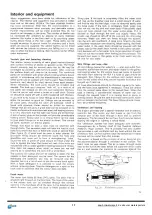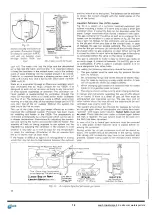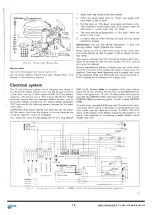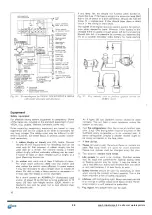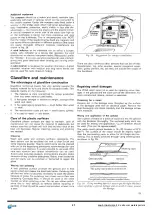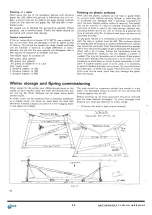
Sails do require s o m e maintenance. W h a t spoils the sails
is c h a f i n g , too much f l o g g i n g , over s t r e t c h i n g , w r i n k l e s ,
moisture, dirt, salt, mildew and direct e x p o s u r e to the sun.
S o m e parts of the sail are more v u l n e r a b l e to chafe than
others. The head and clew, batten p o c k e t s , the luff and foot
w h e r e pulled into the mast and boom are particularly ex-
p o s e d . The part of the mainsail that lies a g a i n s t the spreaders
when running and the parts of the headsails which c o m e into
contact w i t h the s p r e a d e r s and shrouds are particularly liable
co be d a m a g e d . M o d e r n synthetic sail c l o t h is much stronger
than c o t t o n and not so soft w h i c h means that the stitching
does not sink into the cloth as it does on cotton sails.
This means that the stiching is e x p o s e d and likely to be
c h a f e d . It is necessary to check the s e a m s periodically and
to c a r r y out repairs b e f o r e the damage becomes t o o exten-
sive. Temporary repairs can be made w i t h tape and there is
a tape made specially for the purpose. It is important to as-
certain the cause of any damage so that precautions can
be taken to avoid a recurrance. These can take the form of
altering the position of a sheet lead, c o v e r i n g the spreaders
or r e i n f o r c i n g the sails at exposed places. Flogging spoils
the sails and should be avoided. W e t sails should be dried
Engine installation in VEGA
Even the best engine needs certain maintenance to do a
g o o d j o b . Therefore it will pay to c a r e f u l l y read this instruc-
tion. See also the engine manual.
V E G A has a variable pitch propeller w i t h a feathering posi-
tion for sailing. It is o p e r a t e d by a single lever remote control
w h i c h engages the manoeuvring m e c h a n i s m . This s y n c h r o -
nizes the pitch of the propeller blades w i t h the engine speed
by the throttle lever.
The c o n s t r u c t i o n of the exhaust system eliminates the risk
of w a t e r entering into the engine when s a i l i n g . The exhaust
pipe is enclosed in a length of 1.8 m (6 ft) by a water jacket
c o n s i s t i n g of a rubber hose. The w a t e r is entering the jacket
in its f o r w a r d part and is led out in its rear part. The water
is f u r t h e r led to the outlet side of the exhaust pipe w h e r e it
is entering the gas stream. The w a t e r has here partly a
cooling and partly a silencing function. W i t h other w o r d s , the
engine has a dry exhaust pipe except f o r the very rear part.
Thanks to the so called " g o o s e n e c k " at the stern water
cannot enter the engine this way.
Manoeuvring
W h e n the operating lever (fig. 13) is in neutral the engine is
idling and the propeller blades are in neutral position. W h e n
the lever is moved f o r w a r d the propeller pitch as w e l l as the
engine speed is increased in correct p r o p o r t i o n s . At full
engine s p e e d the p r o p e l l e r pitch can be further increased
— this w i l l however, cause reduced engine speed. For run-
ning astern, move the operating lever aft f r o m the neutral
position.
If y o u move the control lever as far aft as possible when the
engine is not running the propeller blades are feathered to
achieve least possible drag when sailing. By alining indicator
marks on the flywheel or the propeller shaft (engine M D 6 A )
the p r o p e l l e r blades are put in vertical p o s i t i o n . The propeller
pitch has to be adapted to the sea c o n d i t i o n s . W h e n going
against rough sea, full pitch cannot be used. W h e n going
w i t h t h e sea, a b i g g e r pitch may give i n c r e a s e d s p e e d . For
cruising economy the engine revs o u g h t to be about 1 5 %
less than maximum o b t a i n e d .
Running
W h e n running check at regular intervals that the t w o control
lights are not glowing and that the c o o l i n g w a t e r temperature
by spreading them out in the sun and only in a very light
w i n d s h o u l d they be h o i s t e d to dry.
W r i n k l e s make the sails less effective. Sails should, t h e r e -
fore, not be stuffed into bags which are t o o small. It is b e s t
to fold sails parallell to the foot and then to roll them l o o s e l y
around the luff. A sail must of course be d r y before being
bagged. It is easiest to detect the p r e s e n c e of moisture by
feeling the tack. Dirt and mildew may not damage a sail but
they look unsightly. Salt makes sails heavier and it also
attracts moisture which w i l l make them heavier still. Salt is
best r e m o v e d by hosing the sail w i t h f r e s h water.
Polyester fibre and nylon are resistent to sun but age faster
if exposed to too much sun. It is important to protect the
mainsail w i t h a cover w h e n it is left on the b o o m . Best of all,
remove it f r o m the b o o m and take it b e l o w . Dirty sails can
be w a s h e d in luke w a r m w a t e r and a mild detergent. If the
sail is t o o big t o be rinsed in a bath tub, spread it on a floor,
hose it w i t h fresh water and scrub it w i t h a soft brush. G r e a s e
can be r e m o v e d with t r i c h l o r e t h y l e n e . In w i n t e r the sails
should be clean and d r y and folded loosely in their bags.
They s h o u l d be stored in a dry, well v e n t i l a t e d place.
is normal. It is regulated by a built-in t h e r m o s t a t and needs
no manual adjustment. The t e m p e r a t u r e indicator shall be
within the g r e e n area of the gauge or 7 5 — 8 5 ° C .
Check b e f o r e starting: Remaining fuel, engine oil level and
battery electrolyte level. In a calm the cruising speed at 8 5 %
engine revs is about 6 knots and at max. revs approx. 6.8
knots. B e c a u s e of the low propeller revs and the large p r o -
peller the speed reduction in headwind and head seas is
c o m p a r a t i v e l y small.
Petrol engine ALBIN 0-22 (1970-1972)
Technical data
Engine model A L B I N 0 - 2 2 C o m b i ,
2-cylinder, 4-stroke
Bore 78 mm (3.07")
Stroke 92 mm (3.62")
C y l i n d e r capacity 0.88 litres (54 cu.in.)
C o m p r e s s i o n ratio 5.6:1
Output S A E 12 hp at 1600 rpm
Idling about 500 rpm
C a r b u r e t t o r S o l e x 26 V B N - 2
Spark plug Bosch M45T1
Spark gap 0.6 mm (0.025")
Tappet clearance with c o l d engine
Inlet valve 0.20 mm (0.008")
Outlet valve 0.25 mm (0.010")
Fuel c o n s u m p t i o n at cruising speed approx. 2 lit/h
(0.45 imp. gal/h)
Starting
1. Turn on the main s w i t c h (on the port side in the engine
room, under the stop).
2. Start the fan 11, f i g u r e 15, for ventilation of the engine
room, under the step).
3. O p e n the fuel cock under the petrol tank.
4. Put the operating lever, figure 13, in neutral.
5. Pull out t h e switch 5, figure 15.
6. Press the starter button 4, figure 15. A t cold and humid
w e a t h e r it may be necessary to use the choke 6, w h i c h
11
13


